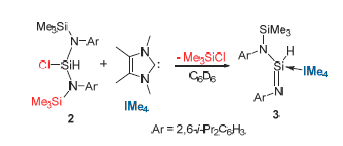| [1] (a) Xiong, Y.; Yao, S.; Driess, M. Angew. Chem., Int. Ed. 2013, 52, 4302.
(b) Fischer, R. C.; Power, P. P. Chem. Rev. 2010, 110, 3877.
(c) Power, P. P. Chem. Rev. 1999, 99, 3463.
[2] (a) Muck, F. M.; Ulmer, A.; Baus, J. A.; Burschka, C.; Tacke, R. Eur. J. Inorg. Chem. 2015, 1860.
(b) Cui, H.; Ma, B.; Cui, C. Organometallics 2012, 31, 7339.
(c) Kocher, N.; Henn, J.; Gostevskii, B.; Kost, D.; Kalikhman, I.; Engels, B.; Stalke, D. J. Am. Chem. Soc. 2004, 126, 5563.
(d) Kocher, N.; Selinka, C.; Leusser, D.; Kost, D.; Kalikhman, I.; Stalke, D. Z. Anorg. Allg. Chem. 2004, 630, 1777.
(e) Niessmann, J.; Klingebiel, U.; Schäfer, M.; Boese, R. Organometallics 1998, 17, 947.
(f) Denk, M.; Hayashi, R.; West, R. J. Am. Chem. Soc. 1994, 116, 10813.
(g) Stalke, D.; Klingebiel, U.; Sheldrick, G. M. J. Organomet. Chem. 1988, 344, 37.
[3] (a) Wiberg, N.; Schurz, K.; Fischer, G. Angew. Chem., Int. Ed. Engl. 1985, 24, 1053.
(b) Wiberg, N.; Schurz, K.; Reber, G.; Müller, G. J. Chem. Soc., Chem., Commun. 1986, 591.
(c) Hesse, M.; Klingebiel, U. Angew. Chem., Int. Ed. Engl. 1986, 25, 649.
[4] (a) Azhakar, R.; Roesky, H. W.; Holstein, J. J.; Pröpper, K.; Dittrich, B. Organometallics 2013, 32, 358.
(b) Samuel, P. P.; Azhakar, R.; Ghadwal, R. S.; Sen, S. S.; Roesky, H. W.; Granitzka, M.; Matussek, J.; Herbst-Irmer, R.; Stalke, D. Inorg. Chem. 2012, 51, 11049.
(c) Zhang, S.-H.; Yeong, H.-X.; So, C.-W. Chem.-Eur. J. 2011, 17, 3490.
(d) Kong, L.; Cui, C. Organometallics 2010, 29, 5738.
(e) Iwamoto, T.; Ohnishi, N.; Gui, Z.; Ishida, S.; Isobe, H.; Maeda, S.; Ohno, K.; Kira, M. New J. Chem. 2010, 34, 1637.
[5] (a) Khan, S.; Sen, S. S.; Kratzert, D.; Tav?ar, G.; Roesky, H. W.; Stalke, D. Chem.-Eur. J. 2011, 17, 4283.
(b) Ghadwal, R. S.; Roesky, H. W.; Schulzke, C.; Granitzka, M. Organometallics 2010, 29, 6329.
[6] Cui, H.; Cui, C. Chem.-Asian J. 2011, 6, 1138.
[7] (a) Hssf, M.; Schmedake, T. A.; West, R. Acc. Chem. Res. 2000, 33, 704.
(b) Driess, M.; Block, S.; Brym, M.; Gamer, M. T. Angew. Chem., Int. Ed. 2006, 45, 2293.
[8] Denk, M.; Lennon, R.; Hayashi, R.; West, R.; Belyakov, A. V.; Verne, H. P.; Haaland, A.; Wagner, M.; Metzler, N. J. Am. Chem. Soc. 1994, 116, 2691.
[9] (a) Inoue, S.; Leszczyńska, K., Angew. Chem., Int. Ed. 2012, 51, 8589.
(b) Asay, M.; Inoue, S.; Driess, M., Angew. Chem., Int. Ed. 2011, 50, 9589.
(c) Jutzi, P.; Leszczyńska, K.; Neumann, B.; Schoeller, W. W.; Stammler, H.-G. Angew. Chem., Int. Ed. 2009, 48, 2596.
(d) Driess, M.; Yao, S.; Brym, M.; van Wüllen, C.; Lentz, D. J. Am. Chem. Soc. 2006, 128, 9628.
(e) So, C.-W.; Roesky, H. W.; Magull, J.; Oswald, R. B. Angew. Chem., Int. Ed. 2006, 45, 3948.
(f) Kira, M.; Ishida, S.; Iwamoto, T.; Kabuto, C. J. Am. Chem. Soc. 1999, 121, 9722.
(g) Gehrhus, B.; Lappert, M. F.; Heinicke, J.; Boese, R.; Bläser, D. J. Chem. Soc., Chem. Commun. 1995, 1931.
[10] Cui, H.; Shao, Y.; Li, X.; Kong, L.; Cui, C. Organometallics 2009, 28, 5191.
[11] Ghadwal, R. S.; Roesky, H. W.; Merkel, S.; Henn, J.; Stalke, D. Angew. Chem., Int. Ed. 2009, 48, 5683.
[12] (a) Agou, T.; Hayakawa, N.; Sasamori, T.; Matsuo, T.; Hashizume, D.; Tokitoh, N. Chem.-Eur. J. 2014, 20, 9246.
(b) Inoue, S.; Eisenhut, C. J. Am. Chem. Soc. 2013, 135, 18315.
(c) Al-Rafia, S. M. I.; McDonald, R.; Ferguson, M. J.; Rivard, E. Chem.-Eur. J. 2012, 18, 13810.
(d) Tanaka, H.; Ichinohe, M.; Sekiguchi, A. J. Am. Chem. Soc. 2012, 134, 5540.
(e) Ghadwal, R. S.; Roesky, H. W.; Merkel, S.; Henn, J.; Stalke, D. Angew. Chem., Int. Ed. 2009, 48, 5683.
(f) Filippou, A. C.; Chernov, O.; Schnakenburg, G. Angew. Chem., Int. Ed. 2009, 48, 5687.
[13] (a) Filippou, A. C.; Chernov, O.; Blom, B.; Stumpf, K. W.; Schnakenburg, G. Chem.-Eur. J. 2010, 16, 2866.
(b) Gao, Y.; Zhang, J.; Hu, H.; Cui, C. Organometallics 2010, 29, 3063.
[14] Cui, H.; Cui, C. Dalton Trans. 2011, 40, 11937.
[15] Scott, N. M.; Dorta, R.; Stevens, E. D.; Correa, A.; Cavallo, L.; Nolan, S. P. J. Am. Chem. Soc. 2005, 127, 3516.
[16] Kuhn, N.; Kratz, T. Synthesis 1993, 561. |
